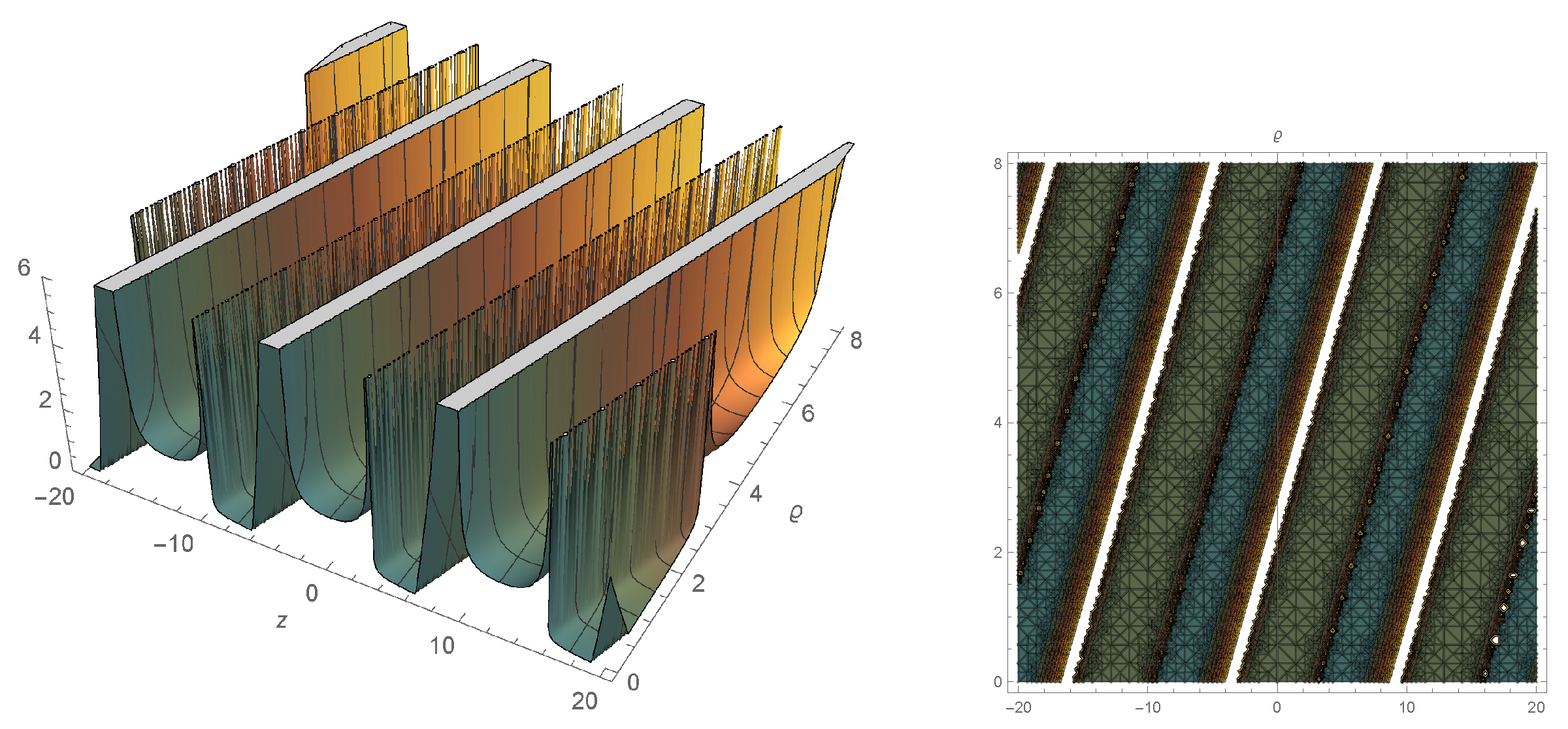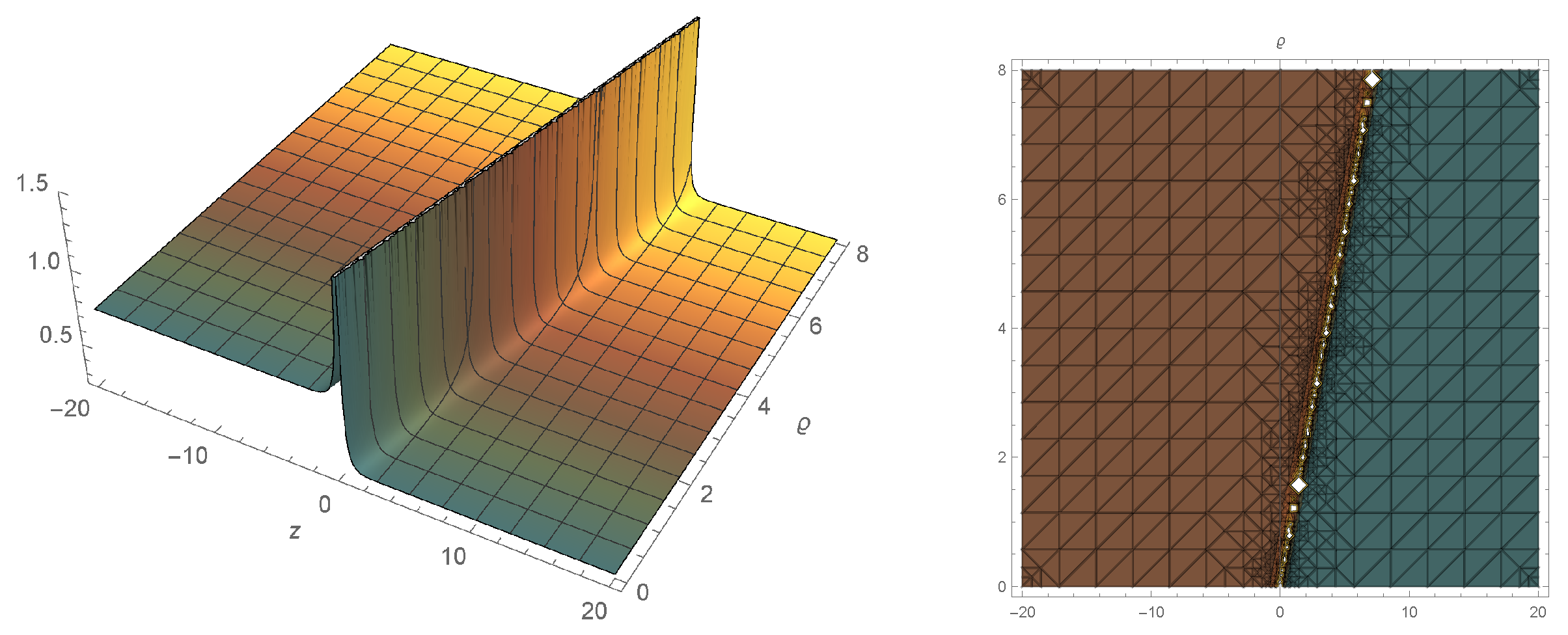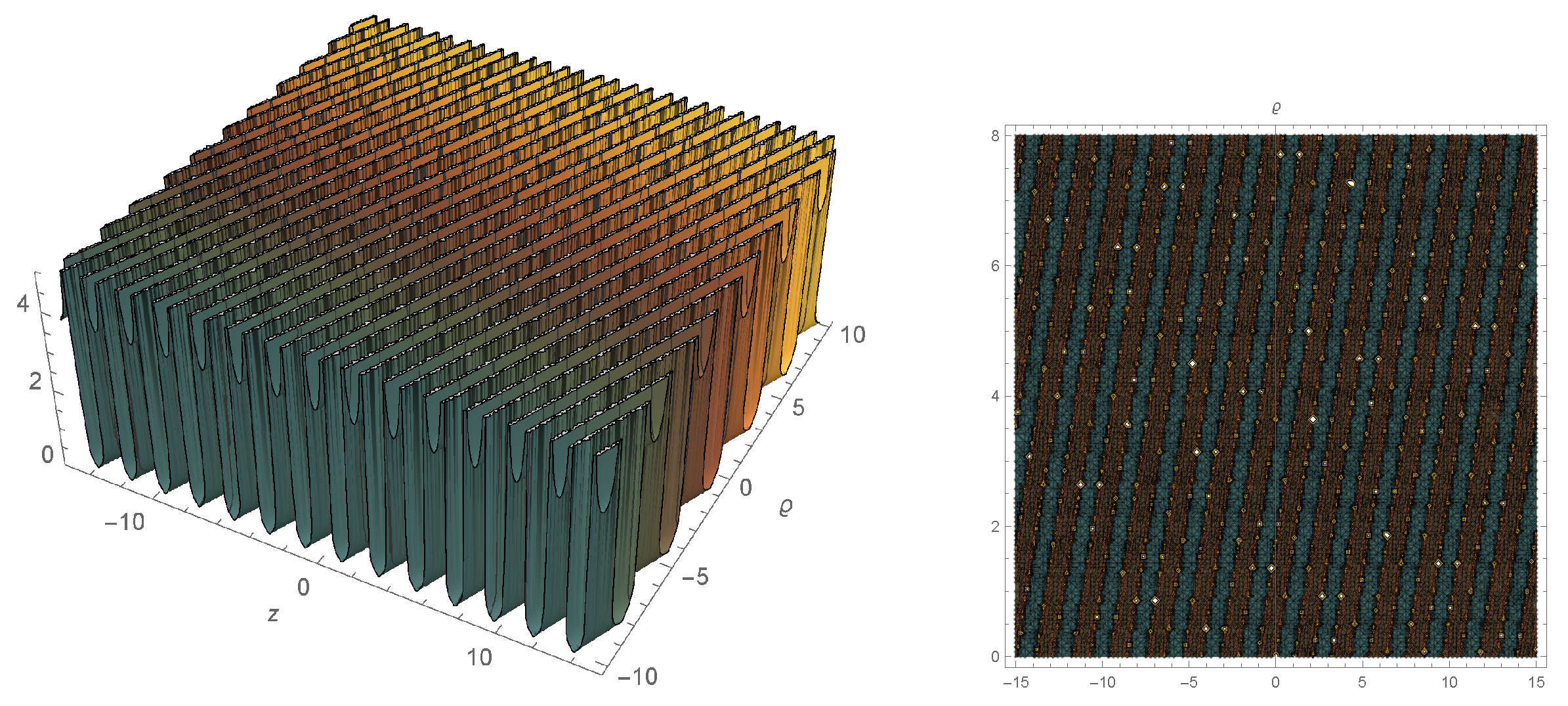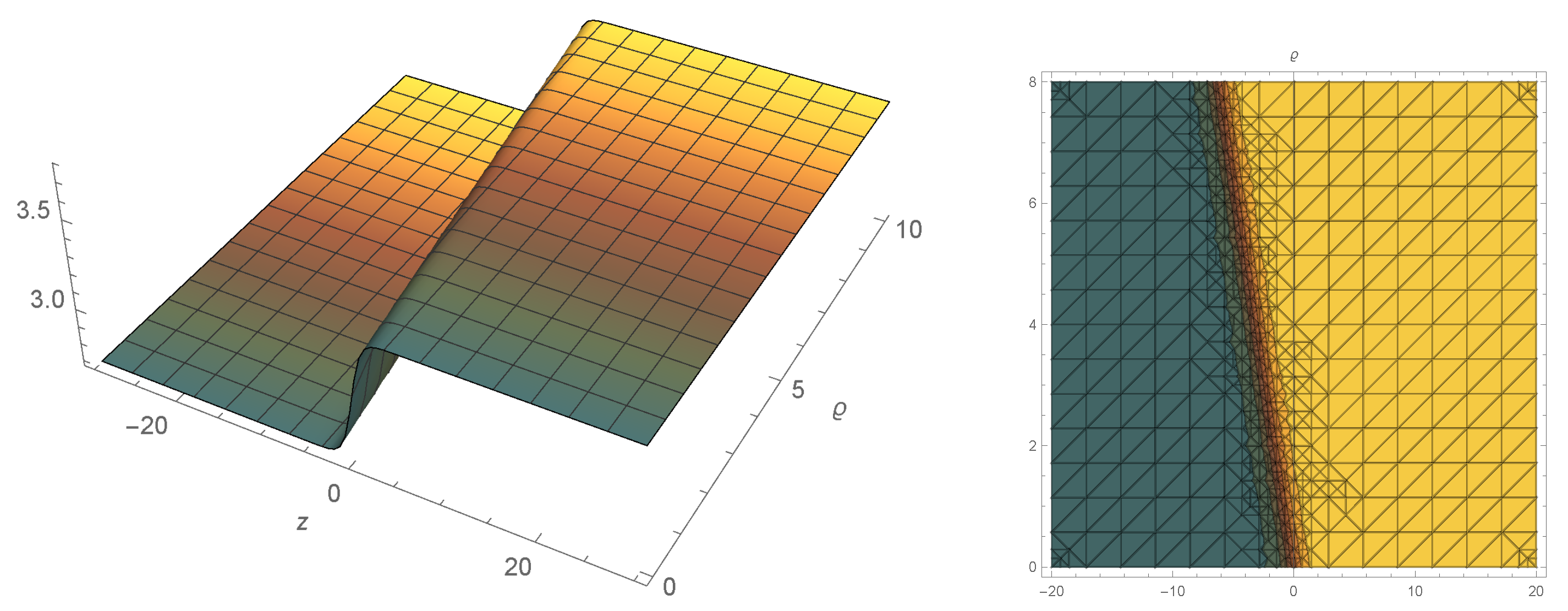Soliton Solutions and Other Solutions for Kundu–Eckhaus Equation with Quintic Nonlinearity and Raman Effect Using the Improved Modified Extended Tanh-Function Method
Abstract
:1. Introduction
2. Summary Method
- Step (1): Using the following traveling wave transformation:
- Step (3): After that, we evaluate the value of the number M, which should be a positive integer number, by applying the balancing principle between the highest-order linear term and the nonlinear term in Equation (4).
3. Solitons and Other Solutions
- Case (1): If setting , then we have
- (1.1)
- If , then a singular periodic solution will be obtained under the constraint as follows:
- (1.2)
- If , and under the condition that is , then a solution in a rational form can be obtained as follows:
- (2.1)
- (2.2)
- Then, from the above case (2.1), obtaining the corresponding solutions of Equation (1) will be as follows:
- (2.1,1)
- If , and and under the conditions that and , then a singular soliton solution can be obtained as follows:
- (2.1,2)
- If , and , and under the conditions that and , then a periodic solution can be obtained as follows:
- (2.1,3)
- If , and , and under the conditions that and , then a Jacobi elliptic solution can be obtained as follows:where .If , a singular soliton solution can be obtained as follows:
- (2.2,1)
- If , and and under the condition that , then a singular soliton solution can be obtained as follows:
- (2.2,2)
- If , and , and under the condition that , then a periodic solution can be obtained as follows:
- (2.2,3)
- If , and , and under the condition that , then we obtain a Jacobi elliptic solution as follows:where .If we set , a singular soliton solution can be obtained as follows:
- (3.1)
- (3.2)
- (3.1,1)
- If , and under the condition that , then a bright soliton solution shall be found as follows:
- (3.1,2)
- If , and under the condition that , then a periodic solution can be found as follows:
- (3.1,3)
- If , and under the condition that , then a solution in the rational form can be obtained as follows:
- (3.2,1)
- If , and under the condition that , then a bright soliton solution can be obtained as follows:
- (3.2,2)
- If , and under the condition that , then a periodic solution can be obtained as follows:
- (3.2,3)
- If , and under the condition that , then a rational solution can be obtained as follows:
- Case (4): If we set , then we have two possible sets of solutions of the parameters as follows:
- (4.1)
- Under the condition that , then a solution of the type Weierstrass elliptic doubly periodic can be found as follows:where .
- (4.2)
- Under the condition that , then a solution of the type Weierstrass elliptic doubly periodic can be found as follows:where .
- (6.1)
- If , and under the conditions that , then we obtain an exponential solution as follows:
- (6.2)
- If , and under the conditions that and , then a singular soliton solution can be obtained as follows:
- (7.1)
- If , and under the conditions that and , then a combo periodic solution can be obtained as follows:
- (7.2)
- If , and under the conditions that and , then, we obtain the bright–dark combo soliton solution as follows:
- (7.3)
- If , and under the conditions that , then a dark soliton solution can be obtained as follows:
4. Graphic Representation of Solutions
5. Conclusions
Author Contributions
Funding
Data Availability Statement
Conflicts of Interest
References
- Jagtap, A.D.; Kawaguchi, K.; Karniadakis, G.E. Adaptive activation functions accelerate convergence in deep and physics-informed neural networks. J. Comput. Phys. 2020, 404, 109136. [Google Scholar] [CrossRef] [Green Version]
- Yin, H.M.; Pan, Q.; Chow, K.W. The Fermi–Pasta–Ulam–Tsingou recurrence for discrete systems: Cascading mechanism and machine learning for the Ablowitz–Ladik equation. Commun. Nonlinear Sci. Numer. Simul. 2022, 114, 106664. [Google Scholar] [CrossRef]
- Zhang, R.F.; Li, M.C. Bilinear residual network method for solving the exactly explicit solutions of nonlinear evolution equations. Nonlinear Dyn. 2022, 108, 521–531. [Google Scholar] [CrossRef]
- Alesemi, M.; Iqbal, N.; Botmart, T. Novel analysis of the fractional-order system of non-linear partial differential equations with the exponential-decay kernel. Mathematics 2022, 10, 615. [Google Scholar] [CrossRef]
- Kudryashov, N.A. Optical solitons of the resonant nonlinear Schrödinger equation with arbitrary index. Optik 2021, 235, 166626. [Google Scholar] [CrossRef]
- Kudryashov, N.A.; Biswas, A. Optical solitons of nonlinear Schrödinger’s equation with arbitrary dual-power law parameters. Optik 2021, 252, 168497. [Google Scholar] [CrossRef]
- Kudryashov, N.A. Stationary solitons of the generalized nonlinear Schrödinger equation with nonlinear dispersion and arbitrary refractive index. Appl. Math. Lett. 2022, 128, 107888. [Google Scholar] [CrossRef]
- Hu, X.; Arshad, M.; Xiao, L.; Nasreen, N.; Sarwar, A. Bright-dark and multi wave novel solitons structures of Kaup-Newell Schrödinger equations and their applications. Alex. Eng. J. 2021, 60, 3621–3630. [Google Scholar] [CrossRef]
- Rabie, W.B.; Seadawy, A.R.; Ahmed, H.M. Highly dispersive Optical solitons to the generalized third-order nonlinear Schrödinger dynamical equation with applications. Optik 2021, 241, 167109. [Google Scholar] [CrossRef]
- Nauman, R.N.; Hassan, Z.; Seadawy, A. Computational Soliton solutions for the variable coefficient nonlinear Schrödinger equation by collective variable method. Opt. Quantum Electron. 2021, 53, 1–16. [Google Scholar]
- Mathanaranjan, T.; Rezazadeh, H.; Şenol, M.; Akinyemi, L. Optical singular and dark solitons to the nonlinear Schrödinger equation in magneto-optic waveguides with anti-cubic nonlinearity. Opt. Quantum Electron. 2021, 53, 1–16. [Google Scholar] [CrossRef]
- Chen, J.; Luan, Z.; Zhou, Q.; Alzahrani, A.K.; Biswas, A.; Liu, W. Periodic soliton interactions for higher-order nonlinear Schrödinger equation in optical fibers. Nonlinear Dyn. 2020, 100, 2817–2821. [Google Scholar] [CrossRef]
- Savaissou, N.; Gambo, B.; Rezazadeh, H.; Bekir, A.; Doka, S.Y. Exact optical solitons to the perturbed nonlinear Schrödinger equation with dual-power law of nonlinearity. Opt. Quantum Electron. 2020, 52, 1–16. [Google Scholar] [CrossRef]
- Razzaq, W.; Zafar, A.; Ahmed, H.M.; Rabie, W.B. Construction solitons for fractional nonlinear Schrödinger equation with β-time derivative by the new sub-equation method. J. Ocean. Eng. Sci. 2022. [Google Scholar] [CrossRef]
- Ma, G.; Zhao, J.; Zhou, Q.; Biswas, A.; Liu, W. Soliton interaction control through dispersion and nonlinear effects for the fifth-order nonlinear Schrödinger equation. NOnlinear Dyn. 2021, 106, 2479–2484. [Google Scholar] [CrossRef]
- Liu, S.; Rezaei, S.; Najati, S.A.; Mohamed, M.S. Novel wave solutions to a generalized third-order nonlinear Schrödinger’s equation. Results Phys. 2022, 37, 105457. [Google Scholar] [CrossRef]
- Dutta, H.; Günerhan, H.; Ali, K.K.; Yilmazer, R. Exact soliton solutions to the cubic-quartic non-linear Schrödinger equation with conformable derivative. Front. Phys. 2020, 8, 62. [Google Scholar] [CrossRef]
- Mirzazadeh, M.; Hosseini, K.; Dehingia, K.; Salahshour, S. A second-order nonlinear Schrödinger equation with weakly nonlocal and parabolic laws and its optical solitons. Optik 2021, 242, 166911. [Google Scholar] [CrossRef]
- Yildirim, Y. Bright, dark and singular optical solitons to Kundu–Eckhaus equation having four-wave mixing in the context of birefringent fibers by using of modified simple equation methodology. Optik 2019, 182, 110–118. [Google Scholar] [CrossRef]
- Biswas, A.; Yildirim, Y.; Yasar, E.; Triki, H.; Alshomrani, A.S.; Ullah, M.Z.; Belic, M. Optical soliton perturbation with full nonlinearity for Kundu–Eckhaus equation by modified simple equation method. Optik 2018, 157, 1376–1380. [Google Scholar] [CrossRef] [Green Version]
- Biswas, A.; Ekici, M.; Sonmezoglu, A.; Kara, A.H. Optical solitons and conservation law in birefringent fibers with Kundu–Eckhaus equation by extended trial function method. Optik 2019, 179, 471–478. [Google Scholar] [CrossRef]
- El Sheikh, M.M.A.; Ahmed, H.M.; Arnous, A.H.; Rabie, W.B.; Biswas, A.; Khan, S.; Alshomrani, A.S. Optical solitons with differential group delay for coupled Kundu–Eckhaus equation using extended simplest equation approach. Optik 2020, 208, 164051. [Google Scholar] [CrossRef]
- El-Borai, M.M.; El-Owaidy, H.M.; Hamdy, M.A.; Ahmed, H.A.; Seithuti, M.; Anjan, B.; Milivoj, B. Topological and singular soliton solution to Kundu–Eckhaus equation with extended Kudryashov’s method. Optik 2017, 128, 57–62. [Google Scholar] [CrossRef]
- Triki, H.; Sun, Y.; Biswas, A.; Zhou, Q.; Yıldırım, Y.; Zhong, Y.; Alshehri, H.M. On the existence of chirped algebraic solitary waves in optical fibers governed by Kundu–Eckhaus equation. Results Phys. 2022, 34, 105272. [Google Scholar] [CrossRef]
- Yang, Z.; Hon, B.Y. An improved modified extended tanh-function method. Z. Naturforschung A 2006, 61, 103–115. [Google Scholar] [CrossRef]
- Esen, H.; Ozisik, M.; Secer, A.; Bayram, M. Optical soliton perturbation with Fokas–Lenells equation via enhanced modified extended tanh-expansion approach. Optik 2022, 267, 169615. [Google Scholar] [CrossRef]






Publisher’s Note: MDPI stays neutral with regard to jurisdictional claims in published maps and institutional affiliations. |
© 2022 by the authors. Licensee MDPI, Basel, Switzerland. This article is an open access article distributed under the terms and conditions of the Creative Commons Attribution (CC BY) license (https://creativecommons.org/licenses/by/4.0/).
Share and Cite
Ahmed, K.K.; Badra, N.M.; Ahmed, H.M.; Rabie, W.B. Soliton Solutions and Other Solutions for Kundu–Eckhaus Equation with Quintic Nonlinearity and Raman Effect Using the Improved Modified Extended Tanh-Function Method. Mathematics 2022, 10, 4203. https://doi.org/10.3390/math10224203
Ahmed KK, Badra NM, Ahmed HM, Rabie WB. Soliton Solutions and Other Solutions for Kundu–Eckhaus Equation with Quintic Nonlinearity and Raman Effect Using the Improved Modified Extended Tanh-Function Method. Mathematics. 2022; 10(22):4203. https://doi.org/10.3390/math10224203
Chicago/Turabian StyleAhmed, Karim K., Niveen M. Badra, Hamdy M. Ahmed, and Wafaa B. Rabie. 2022. "Soliton Solutions and Other Solutions for Kundu–Eckhaus Equation with Quintic Nonlinearity and Raman Effect Using the Improved Modified Extended Tanh-Function Method" Mathematics 10, no. 22: 4203. https://doi.org/10.3390/math10224203






